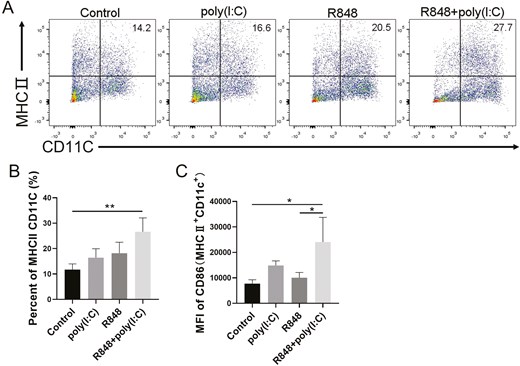-
Views
-
Cite
Cite
Shuanghui Chen, Linzhao Li, Haohua Yuan, Huan Gui, Quan Wan, Mengjiao Wang, Hang Lv, Chenglv Wang, Lan Zhu, Yingjie Nie, Xiangyan Zhang, Intratumoral injection of R848 and poly(I:C) synergistically promoted antitumor immune responses by reprogramming macrophage polarization and activating DCs in lung cancer, Clinical and Experimental Immunology, Volume 219, Issue 1, 2025, uxae110, https://doi.org/10.1093/cei/uxae110
Close - Share Icon Share
Abstract
Immunotherapy has rapidly become a primary treatment option for many lung cancer patients because of its success in treating this prevalent and deadly disease. However, the success of immunotherapy relies on overcoming the immunosuppressive tumor microenvironment, making remodeling this environment a potential strategy for lung cancer therapy. Research suggests that Toll-like receptor (TLR) agonists can impede tumor growth by promoting the conversion of tumor-associated macrophages into an M1-like state or enhancing dendritic cell development. However, there is insufficient research on the combined use of TLR agonists for treating lung cancer.
In this study, we examined how TLR agonists such as resiquimod (R848) and poly(I:C) impact lung cancer treatment when used alone or in combination. In vitro, the regulatory functions and mechanisms of R848 and poly(I:C) were analyzed in primary macrophages, RAW264.7 cells, and primary dendritic cells (DCs). Tumor treatment efficacy was assessed in vivo with a Lewis lung carcinoma (LLC) mouse model.
The combination of R848 + poly(I:C) enhances the transformation of macrophages from the M2 phenotype to the M1 phenotype by increasing inflammatory cytokine levels. The percentage of mature DCs expressing MHC-II+CD11c+ and CD86+ cells was significantly higher in the R848 + poly(I:C) group compared with the other groups. Intratumoral injection of the synergistic combination of R848 + poly(I:C) suppressed tumor growth by increasing the M1:M2 ratio in TAMs, activating DCs, and attracting CD4+ and CD8+ T cells.
R848 + poly(I:C) synergistically induces M1-like polarization of macrophages, activates DCs, and promotes effective antitumor immunity in mice with subcutaneous LLC tumors.






